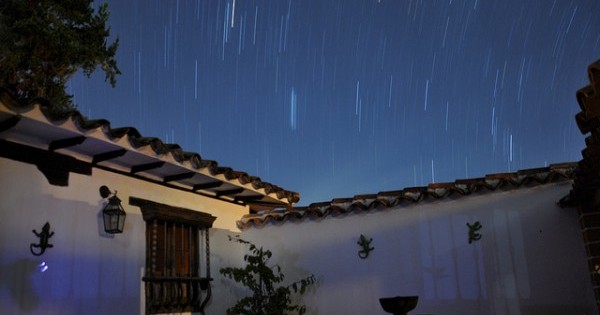
Darkness casts the world in a different light. Colors disappear. The stars come out or clouds race across the moon as gothic as a movie. With darkness—around my Seattle dwelling at least—comes quiet. Airplanes stop droning overhead; buses stop roaring past. By the time of the small hour—1 o’clock—I could almost be living in the country.
After my late evening glass of wine, I generally go out to the front stoop and look up. On clear nights (contrary to popular opinion, we do have them in Seattle), and despite light pollution, I can see the stars, at least some of them. I like picking out the ones I know and learning new ones—easy enough once you put planetarium software on your computer (Stellarium, for example, is free). The virtual sky on your screen is identical to the one overhead, with celestial objects identified and explicated.
We Homo sapiens are diurnal but we need the night, we need the dark, we need the quieter time. We need to sleep and to dream. Life on earth proceeds according to circadian rhythms, bodily rhythms entrained to 24-hour timing cues, mainly the progression of light and dark.
Circadian rhythms in mammals begin with light entering the eye. On the thin sheet of neurons that is the retina, there are retinal ganglion cells whose long axons form part of the optic nerve. But they do nothing for vision. Instead they react to light directly and send their electrical signals to a batch of neurons called the suprachiasmatic nucleus. These nuclei, one on each side, are located on the anterior part of the hypothalamus, below the thalamus, low behind your ears. The suprachiasmatic nuclei serve as the body’s master clock. Their oscillations (rhythmic firings) reach to cells with no access to light, including to the brain’s pineal gland, which produces the hormone melatonin, which makes us sleepy. Circadian rhythms regulate sleeping and waking, body temperature, hormone secretion. They affect hunger, thirst, and mood, and their disruption has a likely role in cancer.
The circadian rhythms that put us to sleep wake the nocturnal animals. At night, owls hunt, frogs croak, and bats do their bat thing. In Florida, baby sea turtles hatch on the beach and crawl home to the moon-illuminated sea. Migratory birds—most of our songbirds—use seasonal rhythms of light and dark to know when to mate and when to migrate.
Too much light deranges circadian rhythms. And that’s what we’ve got—too much light. We need light for safety, but we don’t need wasted light, light that washes out the night sky and harms wildlife. Excessive, misdirected lighting along the coastline causes hatchling sea turtles to turn toward coastal hotels and condos and get lost. Migratory birds smash into illuminated skyscrapers (100 million bird deaths per year, according to the International Dark-Sky Association). Nocturnal animals get mixed up and mate at the wrong time, and their young are born at the wrong time and starve.
I was in the dark about electric lighting but now I have … okay, never mind. Fortunately, light pollution is easy to correct, with concomitant bucks saved, energy conserved, and global warming set back more than a tad, since we spend enormous energy resources toward producing excess, misdirected light. Think hooded porch light, streetlamp pointed downward. Note campaigns by cities (Chicago, Toronto) to dim skyscrapers at night to protect migrating birds. Check out the moves by Flagstaff, Arizona, the world’s first “International Dark-Sky City” and by the Czech Republic, the first country to enact national legislation to curb light pollution. Check out the website of the International Dark-Sky Association.
Our galaxy, the Milky Way, is still up there, in all its glory, even though most of us can’t see it most of the time. Some of us, I believe, have never seen it at all. Its spiral is stunning, brilliant in the blackest of black nights. To see it once again, to gaze at its celestial light, all we need is darkness.

